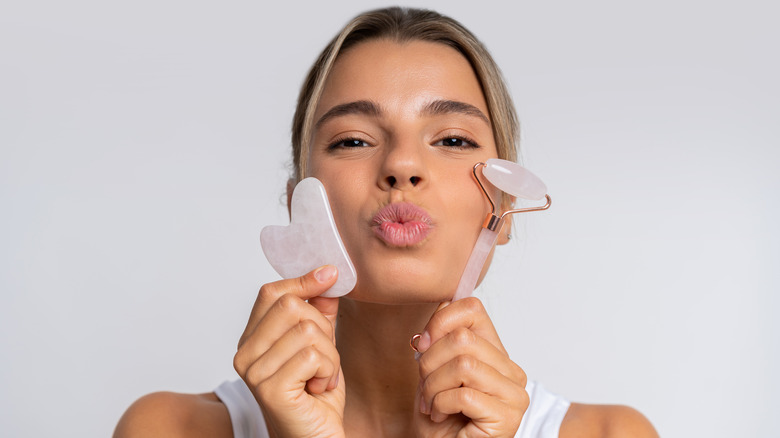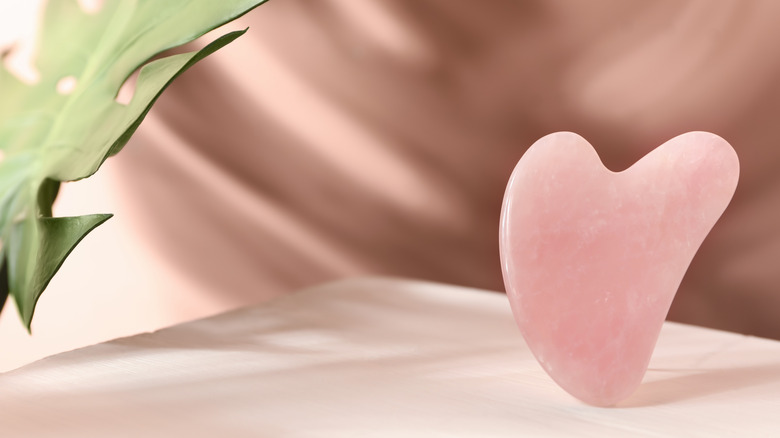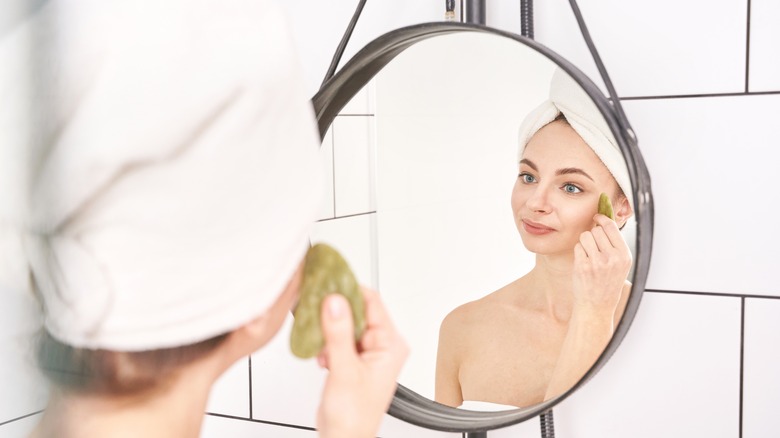How To Wash Your Gua Sha Tools To Keep Your Skin Healthy
Scrolling through your feed, we're sure you've seen those beautiful, fresh-faced women rubbing a smooth stone over their glowing, well-oiled skin. And while you may have chalked it up to just another marketing ploy, this is actually an ancient practice that has been used since the Paleolithic Age (per The Skin Games). Gua sha, a type of massage implemented in Traditional Chinese Medicine (TCM), involves scraping a smooth stone, or gua sha tool, across the skin, moving lymphatic fluid out of the body and improving circulation. Much like acupuncture, it clears sluggish energy and promotes the healthy movement of qi – the energy that makes up our vital life force.
Used on the body, gua sha can relieve pain in the neck, shoulders, lower back, and extremities, and has been used to treat conditions like chronic migraines, perimenopause syndrome, Tourette syndrome, and hepatitis B (per Healthline). However, gua sha facials have gained popularity in the world of beauty and wellness over the last few years, because of their ability to reduce facial tension, puffiness, and the appearance of wrinkles, while enhancing the elasticity skin and giving breakouts and hyperpigmentation the boot (per Prevention).
Like the good little self-care practitioner you are, we know that when you do something to show yourself that you love you, you want to do it right. So we're here to tell you how to best take care of your gua sha tools so that your skin can keep glowing — just like those gals on TikTok.
Gua sha tool qualifications
While Maison Ito notes that traditional gua sha tools were often made from animal bones or soup spoons, the modern gua sha tool is typically made from gemstones like jade, rose quartz, amethyst, nephrite, green aventurine and — the one most often used by TCM practitioners — bian stone. Each stone has its own characteristics, so to speak, offering different benefits when applied to the face.
According to Elle, even more important than the material the tool is made of is the shape of the tool, asserting that it should be small, thin, and smooth with blunt, rounded edges. Mindbodygreen notes that gua sha tools come in many different shapes, often with scallops, ridges, or indentations that can be used to better access different parts of the face.
As facial oil or serum is a necessity for a gua sha facial massage, licensed acupuncturist Tim Sobo explains to Cleveland Clinic that when choosing a tool, the most important thing is finding something that you can easily keep clean.
Why a clean tool is important and how to do it
Just like we cleanse our makeup brushes and regularly replace beauty blenders in order to keep germs away from the delicate skin on our faces, we've also got to keep those gua sha tools squeaky clean. "Similar to our makeup brushes, bacteria can build up [on gua sha tools] and cause breakouts and infections," board-certified dermatologist Sheila Farhang told Byrdie.
Cleaning your gua sha tool is pretty straightforward. Herbalist and acupuncturist Kai Yim recommends using a gentle, antibacterial hand soap and warm water (per Byrdie). You can either lather it up in your hands for 30 seconds before rinsing and drying it off with a microfiber towel, or if you have a little more time, soak it in a bowl of warm soapy water. If you chose a tool that has smaller ridges, Yim says scrubbing those areas with a toothbrush can get rid of any product or debris that may be stuck in the crevices.
When it comes to how often you should be cleaning your tool, Yim encourages us to take a few minutes to clean it immediately after each use to avoid residue being absorbed by the tool, which could cause problems for your skin. If you're hypervigilant about acne-causing bacteria, she says you might even spritz it with alcohol once it's dry.



